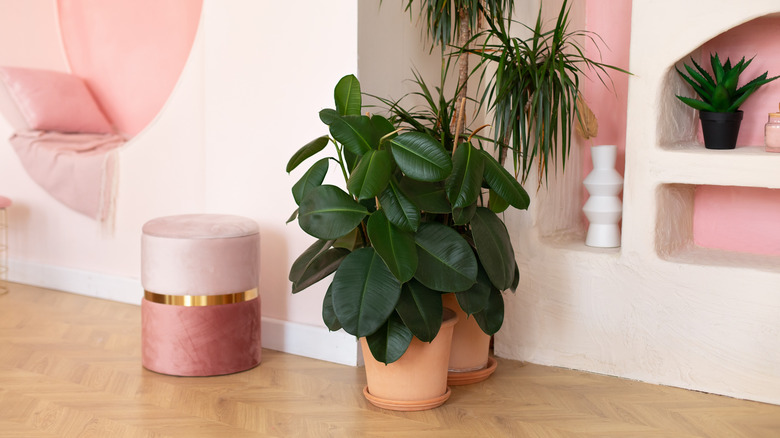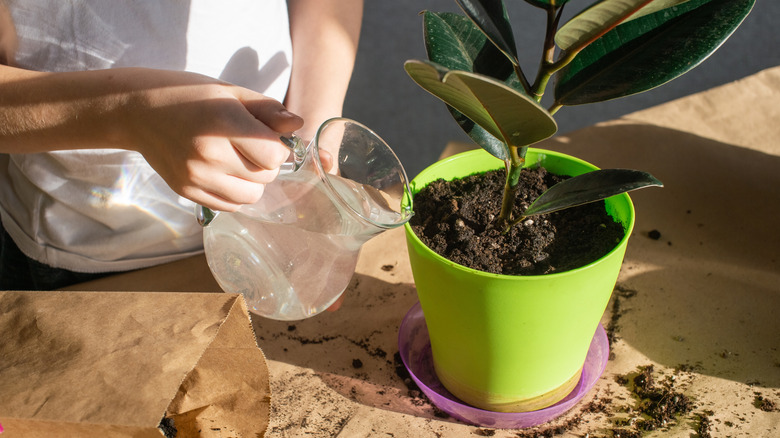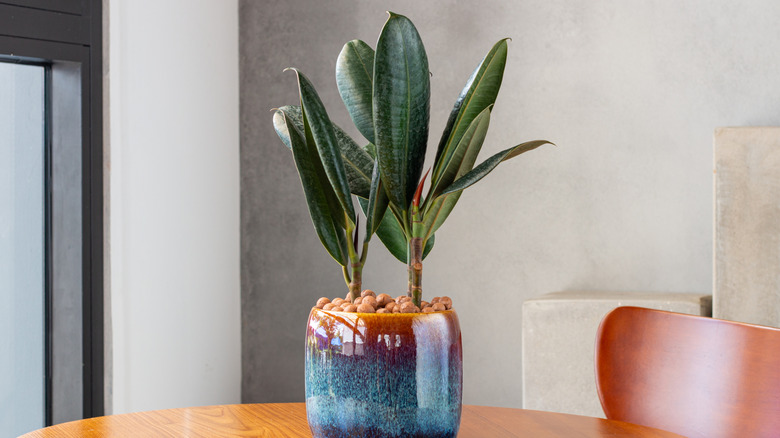Common Mistakes To Avoid When Caring For A Rubber Plant
There's something immensely satisfying about growing a gorgeous rubber plant in your home. If you get it right, you'll be rewarded with a magnificent tropical plant that can reach lofty heights as you continue to replant it into larger pots throughout the years. Although the majestic rubber plant is not that difficult to grow, it does have specific needs you should be aware of, such as correct lighting, temperature, and watering. To that end, you'll want to familiarize yourself with some common mistakes to avoid when caring for your rubber plant, such as overwatering, exposing it to too much direct sunlight, and not providing sufficient humidity.
Like many other houseplants, the rubber plant (Ficus elastica) hails from the tropical rainforests found in Southeast Asia. It's actually a flowering tree that can reach heights of up to 100 feet in its native habitat. However, it's been a popular indoor plant for many, many years now and will grow happily if given the right environment. Ideally, you should think about replicating as much of its natural growing conditions as possible. That includes warmth, indirect light, and humidity, just like what you would find if you stepped into a tropical rainforest.
Common watering mistakes to avoid
Overwatering your rubber plant can be one of the top reasons it fails to thrive. To get this right, you first want to make sure the pot has excellent drainage holes and that the potting mix you're using allows for good drainage as well. Rest assured that it's not difficult to provide your plant with its specific watering needs once you know what they are.
Ideally, you should only water a rubber tree when the soil is dry to the touch. As the plant has large, thick, glossy leaves, it's reasonable to assume that these will absorb and hold more moisture than plants with much smaller leaves. But applying too much too often means the leaves can't absorb it all, and so the excess remains in the soil and causes the roots to rot. You'll find that the rubber tree is one of those houseplants that barely need water. The best thing you can do for your plant is just test the top 1 to 2 inches of soil and only give it a deep soaking when dry. Water deeply until the excess drains out of the bottom of the pot, and never let water remain in the saucer.
Fine-tuning light, temperature, and humidity
Another common mistake you want to avoid is placing your rubber plant directly in front of a window that allows bright sunlight in, as this can quickly burn the leaves. While this is one of the best indoor trees for homes with low lighting, it does prefer bright to medium light, but this needs to be filtered, and morning filtered sunlight is best. You want to ensure that your plant is kept reasonably warm, with daytime temperatures at around 80 degrees Fahrenheit, and don't allow nighttime temperatures to drop below 55 degrees Fahrenheit. It's also important to keep your rubber plant out of drafts to ensure it doesn't experience sudden temperature changes.
Finally, you should consider the humidity needs of your rubber plant. Remember that it originates from a tropical environment, which means it appreciates higher humidity levels than are often present in a home. If you don't have a humidifier, you can easily increase the moisture levels around your plant by setting it in a pebble-filled tray to which you add water. Be sure not to allow the base of the pot to sit in the water, though. As the liquid evaporates, it will help to increase the air moisture around the plant. Now that you know all the mistakes to avoid so your plant thrives and grows, you'll want to understand what to expect when repotting a rubber tree plant and the best way to do it.


